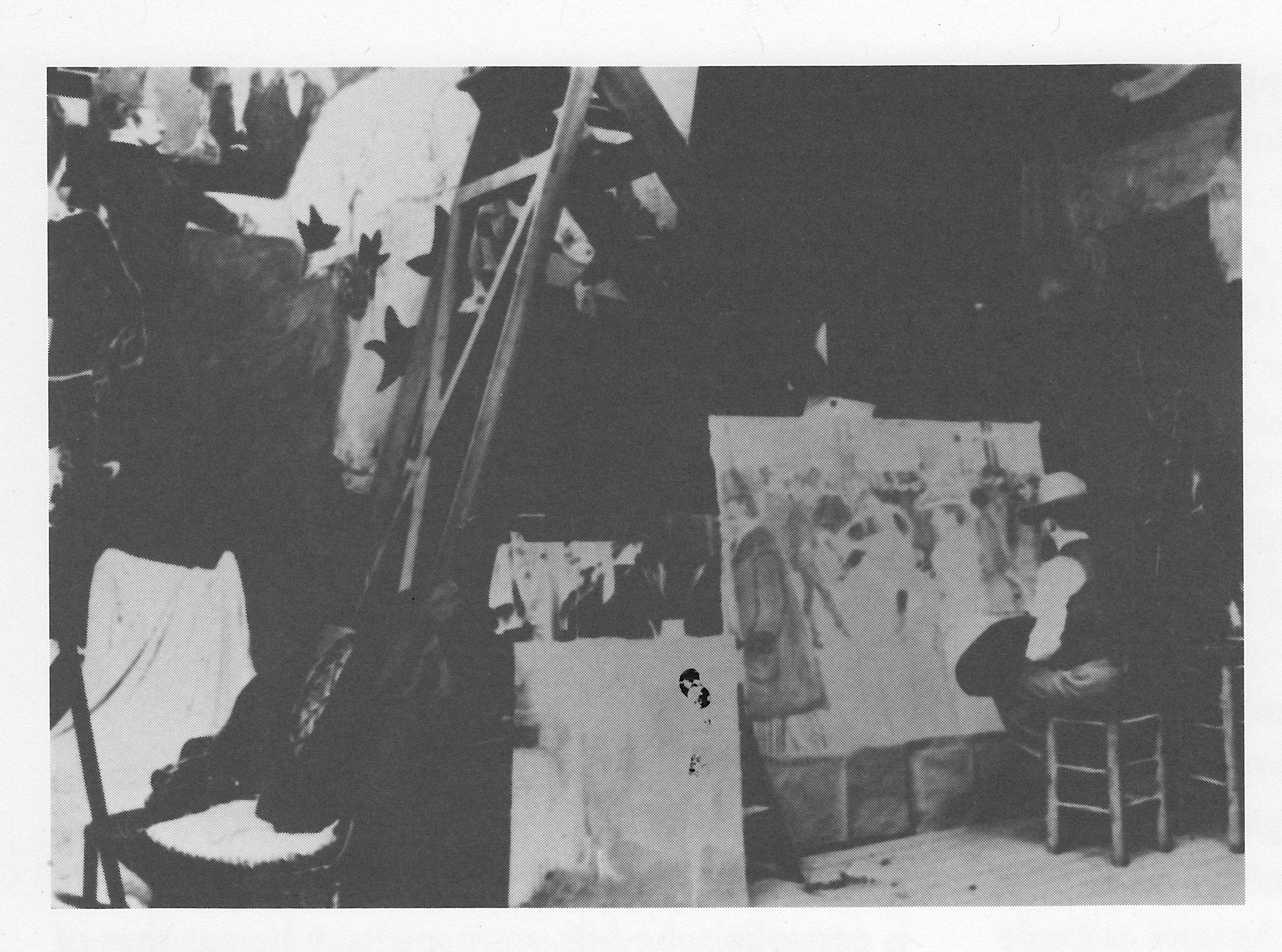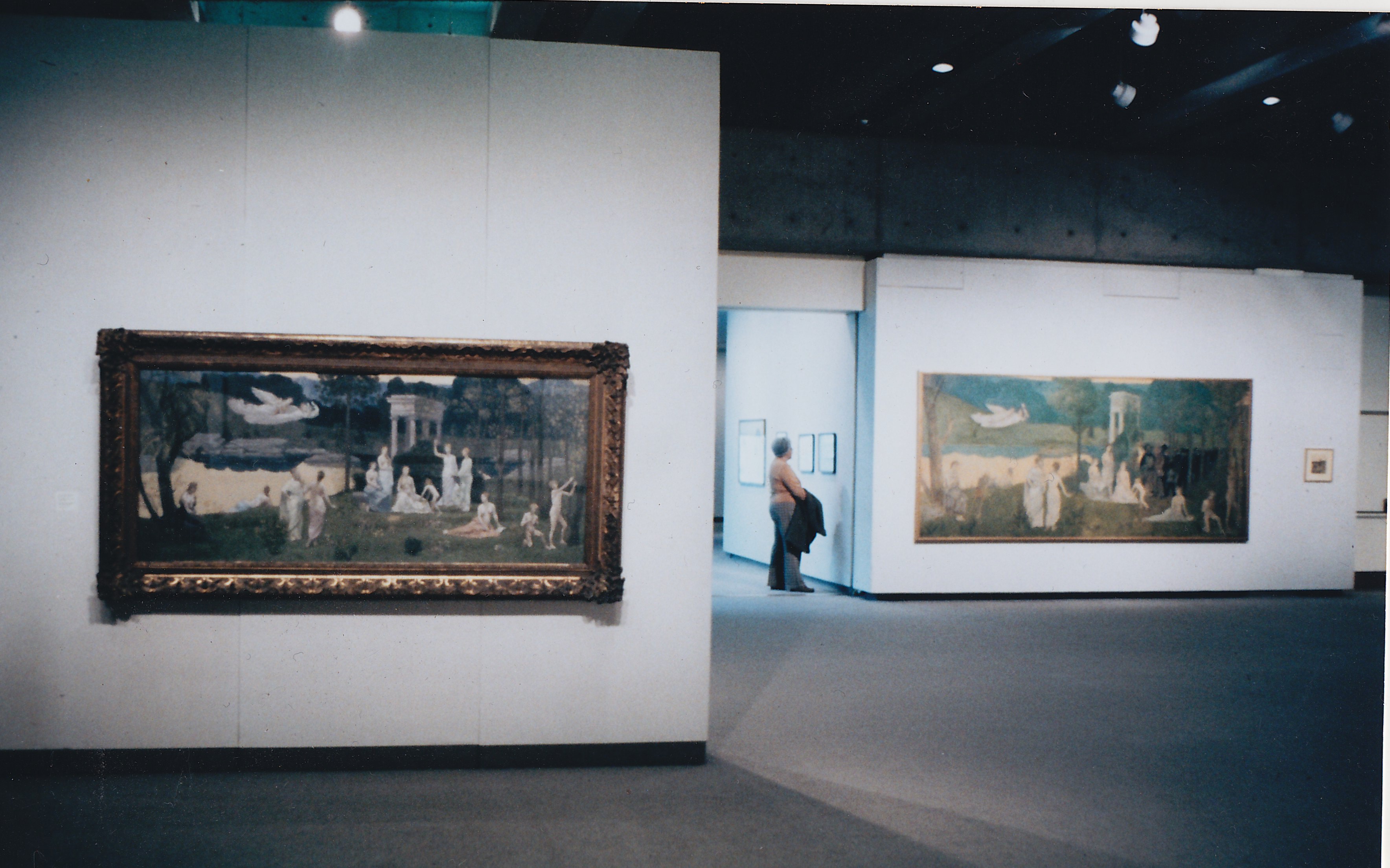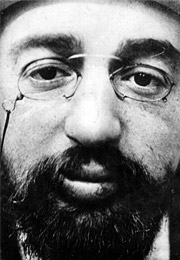


Oil on canvas
172 x 380 cm (67 11/16 x 149 5/8 in.)
frame: 178.1 × 386.4 × 5.7 cm (70 1/8 × 152 1/8 × 2 1/4 in.)
L.1988.62.13
M. Barbazanges, Paris, by 1926. A. M. Marseilles, by 1931. Sold at auction, Hôtel Drouot, Paris, Tableaux Modernes, Aquarelles, Pastels, Dessins…, 30 Mar. 1938, lot 31. Galerie Mouradian et Vallotton, Paris, by 1953; sold to Henry Pearlman, 15 June 1953; Henry and Rose Pearlman Foundation, after 1974.
Toulouse-Lautrec created this work while studying under the painter Fernand Cormon. The painting parodies Pierre Puvis de Chavannes’s “The Sacred Grove, Beloved of the Arts and Muses,” which was awarded the grand prize at the 1884 Paris Salon. Lautrec effectively mimics the style and subject matter of the original but makes significant alterations. Notice the clock on the antique portico and the kneeling adolescent in the corner, eating a loaf of bread. The most irreverent anachronism, however, is the group of men disruptively parading into Puvis’s harmonious forest. They include fellow artists, acquaintances, and Lautrec himself, who stands with his back to the viewer – urinating on the ground.
Photograph of Henri Toulouse-Lautrec in his studio, 1890. The “Sacred Grove” hangs on the right.

Photograph of the 1975 Art Gallery of Ontario exhibition, “Puvis de Chavannes and the Modern Tradition.” Puvis’ “Sacred Grove” hangs in the foreground, left, and Toulouse-Lautrec’s parody in the distance, right.

One of my good friends in Paris had a large Lautrec, which was a parody of a painting of Puvis de Chavannes. It seems that in 1884, Puvis de Chavannes won a prize for a large…
One of my good friends in Paris had a large Lautrec, which was a parody of a painting of Puvis de Chavannes. It seems that in 1884, Puvis de Chavannes won a prize for a large painting, some thirty-two feet long, which is now hanging around the staircase in the Musée de Beaux-Arts de Lyon in France. The painting is titled The Sacred Woods Dear to the Arts and the Muses, with some twelve nymphs. Lautrec, who was twenty years old at the time, made a large parody of this painting, about thirteen feet long and six feet high. He painted exactly in Puvis de Chavannes’s style, but removed the group of nymphs and replaced them with himself, his cousin Tapie de Celeran, Theodore Duret, an art critic of the time, and Willette, a sculptor friend of his and the president of the Beaux Arts. He added a police sergeant who was keeping a group of people from getting into the Sacred Woods. Lautrec also painted a modern clock at the top of a column, and where two angels were carrying a harp in the original he had them carrying a tube of color. At one end of the painting, he took out a maiden and installed instead The Prodigal Son, a subject of another Puvis de Chavannes painting. As this painting was very large, I had to clear it with the Louvre, and it was quite a chore to get their approval to let it leave the country. France that year had just devalued the franc and the government was low on museum funds, so I managed to get an approval. On account of its size I was unwilling to entrust the work to French shipping companies. Instead, I rolled it up and took it with me, and had the frame shipped later.
On the left hand side of the painting was an easel and canvas; primed on the top of the canvas was the name “Mrs. Mackay,” and on the bottom of the canvas, “Meissonier.” I never knew what the names meant; but many years later, reading Leo Stein’s book on Art and Appreciation, I learned that in 1884, the year that Lautrec painted this parody, there was a hue and cry in Paris because Meissonier had done a portrait of Mackay, and on its completion Mackay paid him for it but did not like the picture, and threatened to burn it. All artists claim that no individual has the right to destroy the work of another artist. Lautrec, having a tongue in his cheek when he painted The Sacred Woods, evidently thought this was a timely comment on the affair.

Henri de Toulouse-Lautrec (1864-1901)
Known as much for his flamboyant character as his groundbreaking artwork, Henri de Toulouse-Lautrec (1864–1901) is widely celebrated for paintings, prints, and posters that evoke the dynamic whirl of fin-de-siècle Paris. He developed a distinctive style that used boldly sinuous contours and a sharply hued palette to capture the eccentric characters that frequented Parisian stages, cafés, circuses, and brothels. Toulouse-Lautrec offered a frank depiction of life in the city’s social underbelly, and the graphic innovations that he produced over a short, intense career were extremely influential on following generations of artists. Although he did not affiliate with any particular school, he is often considered one of the major figures of Post-Impressionism.
Toulouse-Lautrec hailed from an aristocratic family in southern France, and from his parents (who were first cousins) inherited a genetic condition that stunted his growth and left him crippled. Surrounded by family members who were amateur artists, Toulouse-Lautrec was encouraged in his artistic pursuits from a young age and found art a welcome distraction, especially while convalescing. Upon moving from Albi to Paris in 1882, he studied in the ateliers of two academic painters—yet he turned toward subjects more in line with the Impressionist painters, focusing on life in the modern city, particularly its margins. Living a bohemian life in Montmartre, he was drawn to subjects such as prostitutes and performers and was perhaps motivated by a sense of identification with the socially marginalized due to his physical deformities. He also became known for his acerbic wit, and at the age of just twenty he created a sensation with his precocious large-scale parody of Puvis de Chavannes’s The Sacred Grove.
A denizen of the Parisian nightlife scene, Toulouse-Lautrec depicted life in the cabarets and theaters he frequented and created influential posters for venues—such as the Moulin Rouge—and their stars. Using new lithographic techniques together with compositional effects derived from Japanese woodblock prints, Toulouse-Lautrec developed indelible icons of Paris as the capital of art and entertainment; these images were at once popular and avant-garde. While his health rapidly deteriorated from 1899 due to a combination of syphilis and alcohol, he created a late body of work that was inspired by a performance of Isidore de Lara’s opera Messaline, which he viewed in Bordeaux. These paintings highlight Toulouse-Lautrec’s attraction to the alternative world of the stage, a realm of artifice and exaggeration.